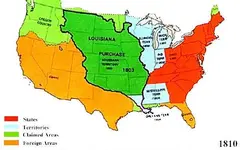Lets break down the great discovery and adventure.
As the story goes, the gold and silver was discovered in a ledge, just as with many other lost treasure tales. What this means is that veins of gold and silver were discovered in this ledge, these veins passing through the various types of host rock much like the veins in one's leg passes through the flesh, muscle, etc., these veins then carrying different levels of impurities from the surrounding host rock. In order to remove this gold and silver from the host rock these veins must be followed and they must be broken and dug away from the surrounding matrix, this initial effort producing ore of various assay. This is where the alleged Beale discovery and adventure (and the alleged mining operation) starts to run into some serious problems.
Because these veins of silver and gold are forced toward he surface from considerable depths in liquid form, those veins closest to the surface are generally the least pure simply because they have passed through so much host rock and all of the various elements associated with it, the cooling process also becoming quicker the closer these liquids get to the surface and as they start to slow down under less pressure, this then trapping more impurities. This is why most of the purest veins are found at considerable depths.
Erosion. As time passes, and since silver and gold are both soft metals, they tend to erode away first until they are released from the host rock and likewise carried down hill into those flowing watersheds where placer gold is often found. It fact, it is this trail of placer gold that has often lead hopeful miners to the “mother lode” or “source” much higher up. Once the mother lode has been discovered this is where “hard rock mining” starts to come into play as the source must be followed into and through the host rock in order to find the purest metals, and hopefully the remaining larger source. Though there are exceptions this is the general manner as to how silver and gold is formed and the how “lode” is located, followed, and recovered in the region in question during the era in question.
Refining. This is the HUGE million dollar problem in the grand Beale adventure, not to mention the general problems and issues associated with hard rock mining during the era and the region in question. Also recall, that according to the tale, for at least half of the year the party was absent half, and one third, of it's number, these absences being associated with Beale's travels and his returns to the east. So right from the very start adjustments have to be accounted for in the actual amount of time that the entire party could have been mining and once this is done suddenly we are down to just a few months.
And as for the refining of the alleged gold and silver, well this represents the absolute sharpest dagger in the tale, as has already been detailed many times over on this thread.
Pickaxes, shovels, sledge hammers, explosives, quick silver, and the list goes on and on, items that a buffalo hunting party certainly didn't have in the required quantity, santa Fe no doubt being unable to fulfill all of this required equipment as well on such short notice, Santa Fe not exactly being the mining capital of New Spain at the time despite what many wish to believe, but just for giggles let's go ahead and entertain this anyway.
So here we have Beale and what remains of the party, Americans no less, shopping through Spanish Santa Fe for all of the required items referenced above, this New Spain mining capital and all of it's resident miners never taking notice or bothering to follow these Americans to their new and fantastical strike that required so much mining essentials. Nor did any of the officials in Spanish Santa Fe object, refuse, or bother to investigate the situation. “Sure, here you go, and go right ahead you lucky devils, we're not the least bit interested.” OK, so it certainly happened that way because the tale says it did.
So here we are now, at the mining site, everyone working their hands and backs to the bone to mine silver ore they can't even refine without considerable loss, the blast from the dynamite never being heard or question by the surrounding inhabitants, the falling of numerous trees for the making of trusses never being noticed as well. While half of the party, of those who still remain, so a total of perhaps seven for part of the year, are tending to the horses and ox and camp and meals, lookout duty, etc., etc., etc., the remaining six or seven continue to dig into and through the hard granite for more “pure ore”, tons of it in fact. Really? People really buy into all of this? In total, horses and everything else that would be required, just how much supply would it take to support this operation and these thirty men for at least two years and where did all keep coming from? The August train, perhaps?
Thirty men, plus Morriss, that's thirty-one shares, but what of the poor guide? Ooops! Guess the author forgot about him, as so often happens in these type of treasure tales. And so on and so on and so on.....






